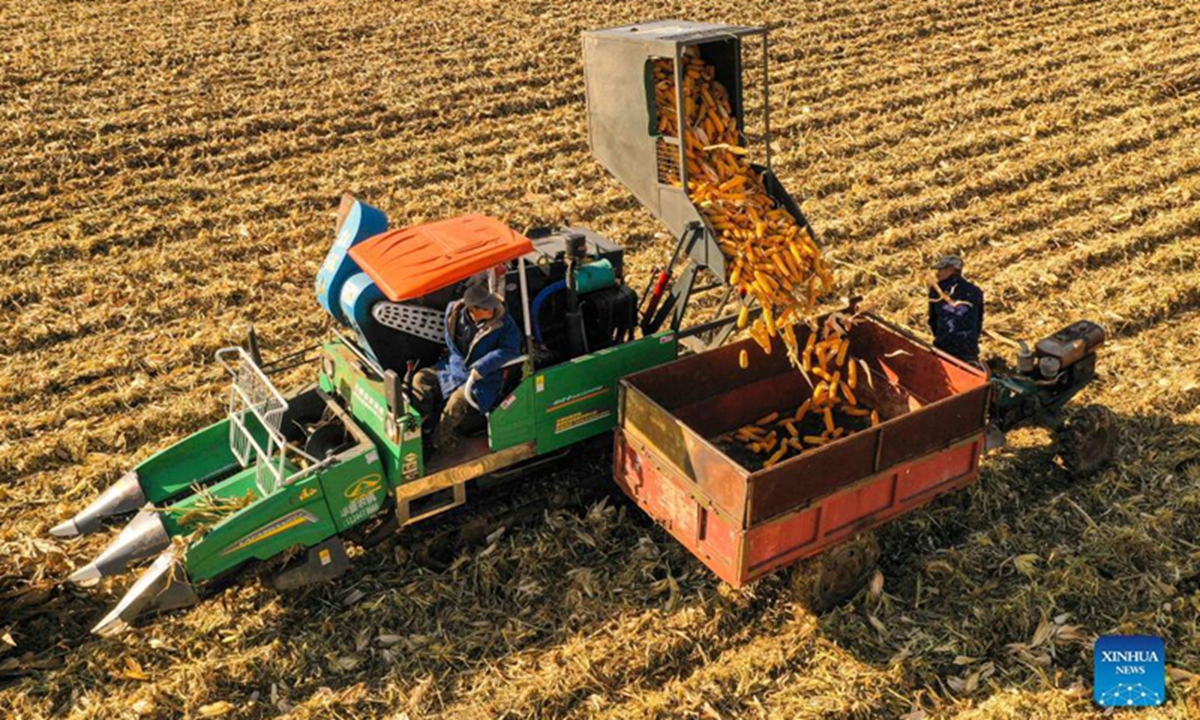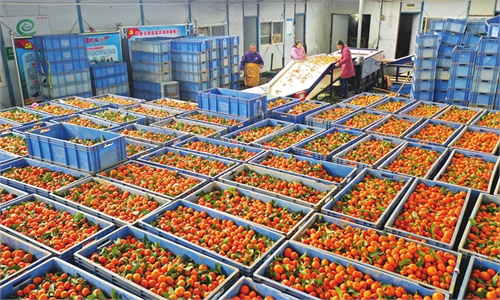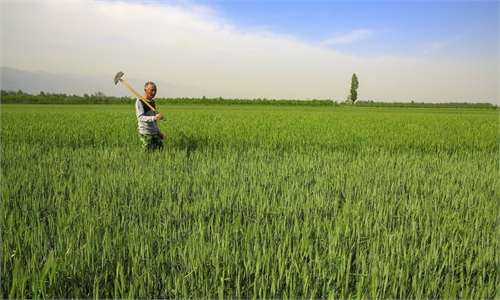
Aerial photo taken on Oct. 10, 2021 shows farmers harvesting corns in Huapichang Town of Jilin City, northeast China's Jilin Province. Jilin recorded a bumper grain harvest, with the total grain output reaching 40.39 million tonnes this year, up more than 2.36 million tonnes year on year, according to data released by the National Bureau of Statistics.Photo: Xinhua
For 19 consecutive years, the Chinese central government's annual "No.1 Document" has been focusing on the "three rural issues," also known as sannong - that is, agriculture, rural areas and farmers. This not only reflects the special importance attached to rural issues in the national governance system, but also identifies key objectives and their realization paths in different periods.
Even against the ongoing global pandemic, China has fulfilled the task of lifting its people out of poverty and has built a moderately prosperous society. The No.1 Document issued this year confronts the challenge of rural revitalization, making systematic deployment for this year's rural development, construction and governance.
The document especially emphasizes the need to guard two baselines, namely, to guarantee national grain security and ensure no reoccurrence of large-scale poverty.
The former lays out a strategic and macro-level scenario, highlighting key aspects such as arable land protection, seed safety, agricultural technology, market regulation, institutional innovation, and so on. The latter calls attention to local support and timely efforts based on the existing experiments in an implementation and meso-level context.
The two baselines entail making good use of the policies at the micro-level. On the one hand, the work on grain security has to give full play to the initiatives of both the farmers and grain-producing zones. In other words, it is of vital importance to mobilize the enthusiasm of the two. The farmers are the direct intended beneficiaries of profitable grain-growing, but encouraging policies are also needed to incentivize the local authorities to grasp the opportunities offered.
On the other hand, we should closely follow those who are vulnerable to returning to poverty. These include households that got out of poverty recently, have low income, suffer sudden serious difficulties, and so on. Only by sharing fruits of economic development can we draw a beautiful picture of rural revitalization and common prosperity.
Facing unprecedented changes in a century, the instability and uncertainty in a thicket of regions around the world continues to deepen. Against the backdrop of the international political and economic environment being more complicated in the near future, the importance of grain security appears to be more prominent.
Ensuring the supply of important agricultural products, especially grain, is the primary task of the rural revitalization strategy. Grain security is first of all reflected in the basic self-sufficiency of grain, and arable land is the lifeblood of grain production. The document proposes to make the protection of arable land a compulsory indicator for local government, with a one-vote veto and lifelong accountability. The introduction and implementation of these "toothed" measures, coupled with technological research and development of agricultural facilities, will further strengthen the agricultural infrastructure and promote the modernization of rural revitalization and rural governance.
China has already eliminated absolute poverty under the current standards. Nevertheless, there is still a need to further increase the income of and protect people at risk of falling back to poverty in some rural areas. The document points out that it is necessary to precisely determine and monitor the vulnerable households, and help to increase sustained income for the targeted ones through industrial employment assistance and public welfare jobs.
Accurately identifying rural households at risk of returning to poverty is an important step toward improving support mechanisms, which in turn have an impact on redistribution and its fairness. As a successful tool used in the past to battle poverty, targeted identification can be utilized to better integrate alleviating poverty and rural revitalization.
Industrial poverty alleviation and employment poverty alleviation play a key role in poverty eradication in that they offer a long-term mechanism of gaining income. Again, measures to promote farm-produce processing, rural tourism and rural e-commerce are still part of the revitalization. In 2021, the per capita net income of the population out of poverty reached 12,550 yuan ($1988), an increase of 16.9 percent over 2020.
In short, the people-centered development thought prevails. Bearing high-quality agriculture, livable countryside and affluent farmers in mind, the work on the three rural issues requires the results of poverty eradication to be consolidated and expanded.
The successive release of the No.1 Document from the central authorities to prioritize arrangements for the work of the three rural issues helps to empower various stakeholders. The combination of competent government and the effective market is one of the basic practices by China on the path to rural revitalization, as well as an important element of the Chinese solution to global poverty governance and common prosperity.
The author is associate professor at the Central Compilation and Translation Bureau. opinion@globaltimes.com.cn



